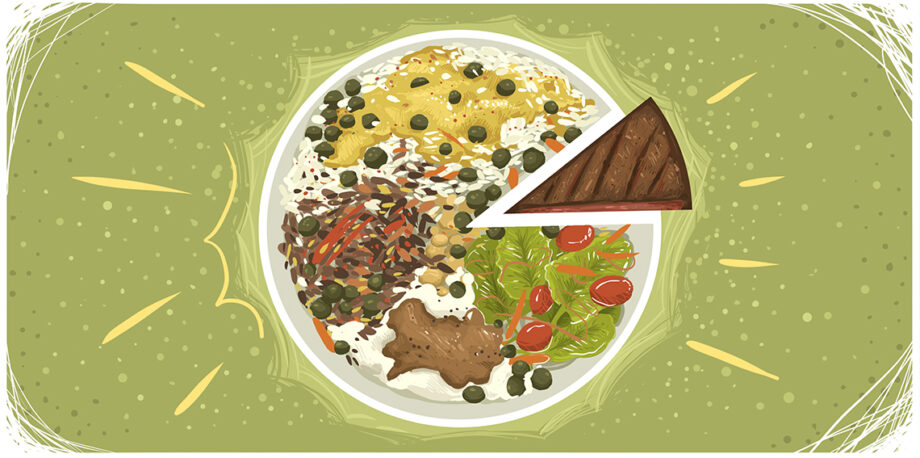October 20, 2015 — Agriculture expansion is the leading driver of natural habitat loss worldwide. However, most of this growth is not to produce vegetables, fruits or grains to be eaten by people. Ecosystems are destroyed overwhelmingly to feed livestock. Livestock production uses roughly three-fourths of all agricultural land and 30 percent of the land surface of earth, making it the largest use of land by humankind. In the Amazon, 70 percent of the deforested land is occupied by cattle pasture, and most of the remaining deforested portion is used to grow crops such as soy for livestock feed. In Costa Rica, a country heralded for protecting its biodiversity, nearly half of the country’s land has been carved from biodiverse tropical forests to produce livestock.
Meanwhile, Iowa, blessed with some of the world’s richest soils, is often considered to be at the heart of America’s “bread basket,” but that is a myth. It is really at the heart of our “meat basket.” Intensively cultivated corn and soybean fields dominate the Midwest and are the primary sources of feed for livestock, which supply America’s staggeringly unhealthy level of demand for animal products — comprising about 45 percent of the nation’s diet by weight. This production comes at a hefty price for the environment. Half of Iowa’s soils have eroded away, laden with overused fertilizers and biocides that find their way into the Mississippi River and devastate marine life at its mouth in the Gulf of Mexico. And the heavy consumption of animal products is a powerful contributor to global climate change, which also threatens biodiversity. Worldwide, the livestock sector is responsible for approximately 15 percent of all human greenhouse gas emissions, about equivalent to all the direct emissions from transportation.
Unfortunately, the meat-intensive diet of America and other western nations is spreading. For generations most of the world has eaten diets largely filled with roots, fruits, vegetables and grains, with a smattering of meat or fish. But the animal-centered diet of modern western nations is increasingly being adopted in developing countries, including those richest in biodiversity. As my colleagues and I noted in a recent study, 15 of the 17 “megadiverse” countries — those that collectively harbor the majority of the Earth’s known species — are developing tropical countries and 11 have increasing rates of per capita meat production. Meanwhile, with continued economic growth, per capita meat consumption in some developing countries can be expected to quickly approach levels found in developed countries.
Effects on Biodiversity
The core of the animal-product problem is that producing protein from meat requires far more land area than does producing protein from plant sources. A pound of protein from chicken requires three times more land area to produce than a pound of soy protein; pork requires nine times more land, and beef, 32 times. To meet livestock production demands over the next 35 years, several megadiverse countries will exceed 30 to 50 percent of their current agricultural areas, and all together the developing tropical megadiverse countries could expand their agricultural areas by an area equivalent to about one-third of the entire United States. In the Philippines, for example, the area of land required for future meat production is projected to exceed 50 percent of the country’s total current agricultural lands — or the equivalent of about 20 percent of the country’s total area and 73 percent of the size of its protected areas. In Costa Rica, livestock grazing in pastures is the top land use, covering four times more area than protected land. Future expansion of land used for meat production would come at a great cost of biodiversity loss, as well as soil erosion and pollution.
Eliminating livestock and growing crops only for direct human consumption could increase the amount of calories that can be produced by an estimated 70 percent.
China will especially have a strong impact because it’s home to about one in five people on Earth and has a relatively low but rapidly rising rate of per capita animal product consumption (10 percent of diet in 1989; 20 percent in 2009; on trajectory to reach 30 percent by 2030). If Chinese animal product consumption levels reach those of the U.S., the effect on biodiversity will be massive — at a distance. Land used for agriculture in China is decreasing because of the needs of other industries and urbanization, so the additional demand must be met by importing meat products and animal feed. Currently, much of the livestock production in the country is possible because of imports of soy for feedstock produced in the Amazon. In fact, approximately 4 million hectares (10 million acres) of cropland in Brazil is used for soybean exports to China to feed livestock.
What to Do?
A rise in meat consumption is not necessary, nor is it inevitable. Diets rich in fruits, vegetables and plant-based protein sources such as whole grains, legumes and nuts are much healthier. Eliminating livestock and growing crops only for direct human consumption could increase the amount of calories that can be produced by an estimated 70 percent. This could feed an additional 4 billion people — significantly more than the projected global population growth of 2 billion to 3 billion — all on existing agricultural lands.
Overall, we should consider meat an occasional treat, decreasing the amount of animal products in the human diet from a current global average of 20 percent to 10 percent or less.
Still, I am not advocating that everyone should be vegan. That is not realistic. And beyond that, there are areas where animal grazing on pasture makes sense. On small-scale farms, especially in poor cultures with marginal lands unsuitable for many agricultural crops, livestock production offers a good way to convert low-protein grass and other plants to more concentrated protein.
Overall, though, we should consider meat an occasional treat, decreasing the amount of animal products in the human diet from a current global average of 20 percent to 10 percent or less. This is roughly equivalent to limiting daily consumption of meat or other animal products to a portion that is approximately the size of a deck of playing cards or smaller. This would greatly reduce environmental impacts of livestock production while allowing us to restore habitats and biodiversity.
Strong impacts can especially be made by reducing our consumption of beef, which has a very large ecological footprint, and shifting that demand to chicken and pork, which require a fraction of the land, water and energy to produce. We should also change the manner in which meats are produced. In developed countries, and increasingly in the rest of the world, meats are produced in high-capacity industrial facilities where large numbers of animals are raised under crowded — and, many people argue, inhumane — conditions. Their feed comes from agricultural systems that require high levels of chemicals, are very prone to soil erosion, are extremely low in biodiversity and are highly dependent on fossil fuel energy. These animals are commonly fed hormones and antibiotics to increase their growth rates and ward off disease, and they produce large amounts of concentrated waste that can pollute local waters.
In contrast, livestock can be integrated into diverse agricultural production systems that strive to minimize fossil fuel and agrochemical use, conserve nutrients and water, and produce little waste. Livestock integrated into such a system consume a variety of feeds, produce nutrient-rich waste that is returned to the system as fertilizer and perform many other services, creating an ecosystem that is far more friendly to biodiversity.
Last, although strategies to produce more sustainable meat are important, great strides are being made to produce meat products that look, sizzle, smell and taste just like the real thing, but are made exclusively from plant-based ingredients. If researchers can produce alternatives to meat that actually put a dent in meat consumption, it could revolutionize the global food industry and help solve the top personal and environmental health problems we face.
But the most important thing we can all do right now to protect biodiversity is this: Eat less meat and more plants. And inspire the rest of the world to do the same. ![]()
Editor’s note: The views expressed here are those of the author and not necessarily of Ensia. We present them to further discussion around important topics. We encourage you to respond with a comment below, following our commenting guidelines, which can be found here. In addition, you might consider submitting a Voices piece of your own. See Ensia’s “Contact” page for submission guidelines.
Ensia shares solutions-focused stories free of charge through our online magazine and partner media. That means audiences around the world have ready access to stories that can — and do — help them shape a better future. If you value our work, please show your support today.
Yes, I'll support Ensia!
